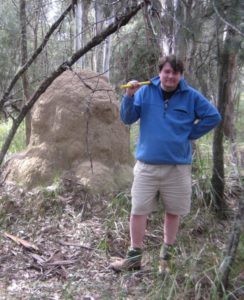Does ant research need taxonomy?
Do we need taxonomy? An old question, but I encounter it quite regularly, for example, when discussing with students in university courses. We used the opportunity of our freshly established blog to probe the community of ant lovers. To do so, we contacted authors of the ten top-cited papers on Formicidae published 2013 to 2017, according to Web of Science, thus reaching researchers from particularly visible fields in myrmecology. We always asked the same three questions and received replies from eight authors. The answers are diverse and yet surprisingly similar … , but read yourself …
Flash interviews compiled by Florian M. Steiner
Researchers in random order; answers not edited
MNB: What do you associate with “alpha taxonomy”?
SLC: Alpha taxonomy is the description of new species – either entirely new discoveries or splitting species out from previously recognised species.
MNB: Is alpha taxonomy relevant for myrmecology and why / why not?
SLC: Of course it’s relevant. Due to their diversity, ants are used extensively as ecological test subjects (e.g., monitoring, impacts research, testing general ecological hypotheses, etc.) which rely on the direct comparability of species-level entities. Without the firm knowledge that all the compared units are the same – that is ‘species’ – the inferences so made are suspect.
MNB: Can you give one example to back up your reply to the previous question?
SLC: The work on ants as bioindicators (e.g., Alan Anderson’s program) results in radically different interpretations with versus without species-taxonomic verification. When assessed as ‘ecotypes’ or other ‘working species classifications’ it’s impossible to test if correlations between morphology and habitat occupancy are due to phenotypic plasticity rather than being true bioindicators.
Daniel J.C. Kronauer  Photo: C. von Beeren
Photo: C. von Beeren
MNB: What do you associate with “alpha taxonomy”?
DJCK: I associate the term “alpha taxonomy” with the thrill of exploring faraway lands, your backyard, or museum collections to discover lifeforms that nobody knew existed.
MNB: Is alpha taxonomy relevant for myrmecology and why / why not?
DJCK: Alpha taxonomy is relevant for myrmecology because ants are incredibly diverse, and much of that biodiversity still remains unknown.
MNB: Can you give one example to back up your reply to the previous question?
DJCK: My favorite example is the recent discovery of the Martialinae, an entirely new ant subfamily that was initially described based on a single specimen fortuitously collected somewhere in the vastness of the Amazon rainforest.
MNB: What do you associate with “alpha taxonomy”?
JG: The excitement of discovery and the hard work of making sure nobody else has already named it!
MNB: Is alpha taxonomy relevant for myrmecology and why / why not?
JG: Absolutely essential for biology, not only for myrmecology; how can we study speciation, biodiversity, or evolution if we don`t have a reliable alpha taxonomy!
MNB: Can you give one example to back up your reply to the previous question?
JG: It makes a big difference for us in terms of techniques and approaches when we study the evolution and genetic architecture of a trait if a polymorphism is intra- or interspecific!
MNB: What do you associate with “alpha taxonomy”?
PSW: In the case of sexually reproducing organisms, alpha-taxonomy operates at the (sometimes fuzzy) boundary between reticulate and tree-like evolution; it attempts to identify evolutionarily independent branches, or species, using diverse lines of evidence (morphological, genetic, geographic, ecological, …), and it employs nomenclatural rules that aim to promote stability and universality of names.
MNB: Is alpha taxonomy relevant for myrmecology and why / why not?
PSW: Yes, alpha-taxonomy is relevant to many aspects of myrmecology, indeed for any study in which species are units of analysis and where the identity of the species matters.
MNB: Can you give one example to back up your reply to the previous question?
PSW: A good understanding of species identities and species boundaries greatly enhances the effectiveness of research on ant evolution, biogeography, comparative biology, or social behavior, and strengthens the conclusions that can be drawn from such research—conversely, in the absence of such understanding, we can be misled by observed patterns of distribution, behavior, and ecology.
MNB: What do you associate with “alpha taxonomy”?
CR: With alpha taxonomy, I associate the process of biodiversity discovery and description, and it integrates identifying species, recognizing new species, and systematically revising and (re)classifying groups of organisms.
MNB: Is alpha taxonomy relevant for myrmecology and why / why not?
CR: In my opinion, alpha taxonomy is very important for myrmecology because many ant species remain to be discovered and described, and the naming of each new species enables us to learn and communicate about the biology of these species and to recognize the important implications they may have for evolutionary biology, biodiversity research, and conservation biology.
MNB: Can you give one example to back up your reply to the previous question?
CR: In my opinion, the discovery and description of Martialis heureka is such an example because the discovery and subsequent analysis of a single new species had important implications for our understanding about the evolutionary history and historical biogeography of the ants.
MNB: What do you associate with “alpha taxonomy”?
VP: I consider alpha taxonomy as the primary method in biological systematics, being the detailed description of a taxon from its morphological characters.
MNB: Is alpha taxonomy relevant for myrmecology and why / why not?
VP: It is definitely relevant for myrmecology because this is the only way to recognize what your eyes actually see of an ant, and there is a large part of the ant diversity that cannot be assessed by any other data.
MNB: Can you give one example to back up your reply to the previous question?
VP: In my field of research, paleomyrmecology, there is nothing but the morphological characters available to describe fossil ants, which would otherwise remain entirely ignored; alpha taxonomy is thus irreplaceable to document the ancient diversity and evolutionary history of ants.
MNB: What do you associate with “alpha taxonomy”?
XC: I associate it with the description of new species or revision and re-classification of former species.
MNB: Is alpha taxonomy relevant for myrmecology and why / why not?
XC: In my opinion, it is essential: We need to name (or to know the names) of our study subjects.
MNB: Can you give one example to back up your reply to the previous question?
XC: I cannot compare the ecological or functional diversity of ant communities if I don’t know the species that they include (if they are unnamed species, I cannot estimate the Shannon index or the weight of each functional trait).
MNB: What do you associate with “alpha taxonomy”?
JAR: When I think of alpha taxonomy, I think of arduous effort and of researchers who love, live, and breathe their organisms.
MNB: Is alpha taxonomy relevant for myrmecology and why / why not?
JAR: Alpha taxonomy is absolutely relevant for myrmecology—ants are so diverse, yet a large fraction of this diversity remains taxonomically uncharacterized; this extends to ant-associated, symbiotic microbes.
MNB: Can you give one example to back up your reply to the previous question?
JAR: Microbes that have come to be prominent and widespread across ants are often given informal names that can vary across publications and research groups; this hinders our ability to discuss these likely impactful symbionts in a common language and it can serve to undermine the rigor of the work in some eyes.












Recent Comments